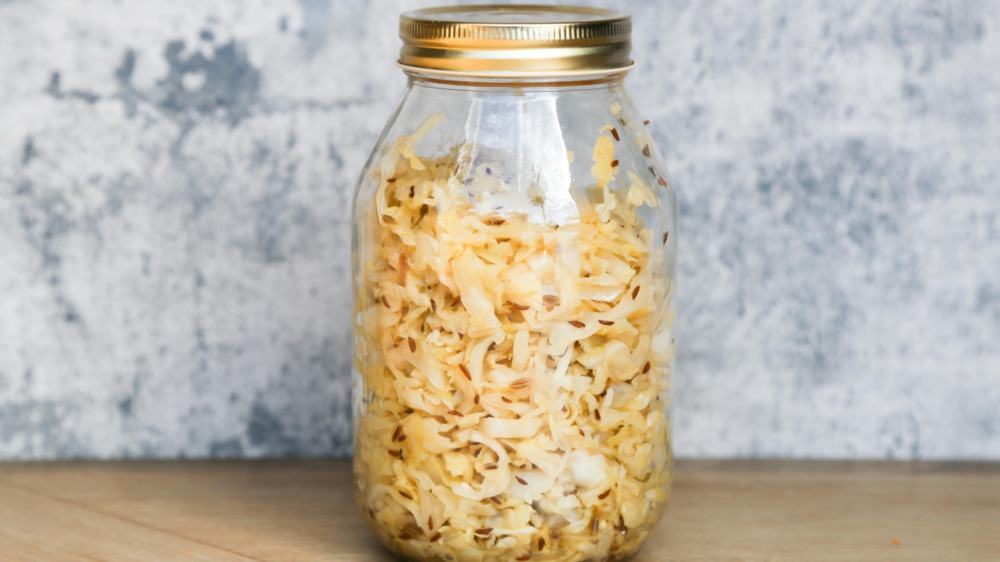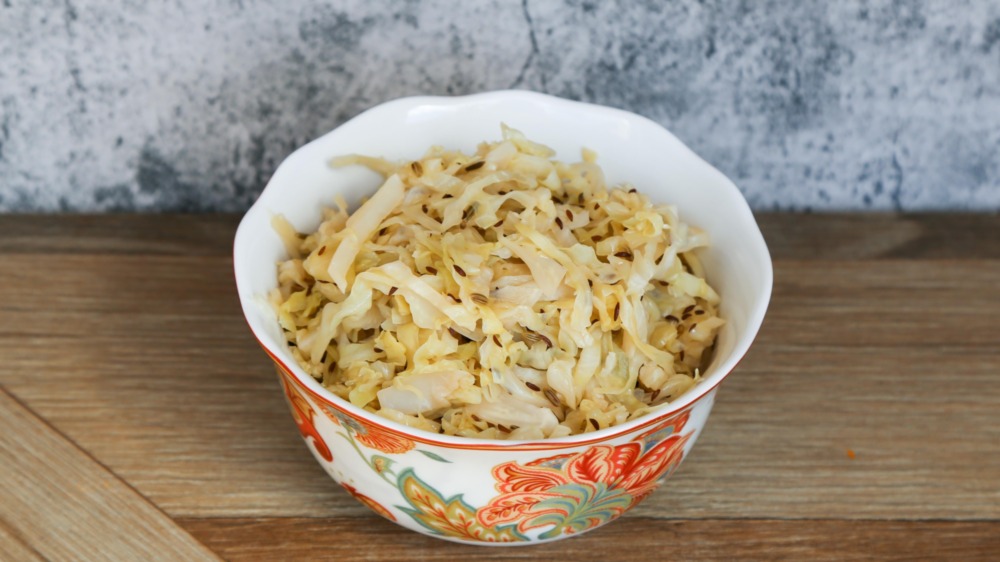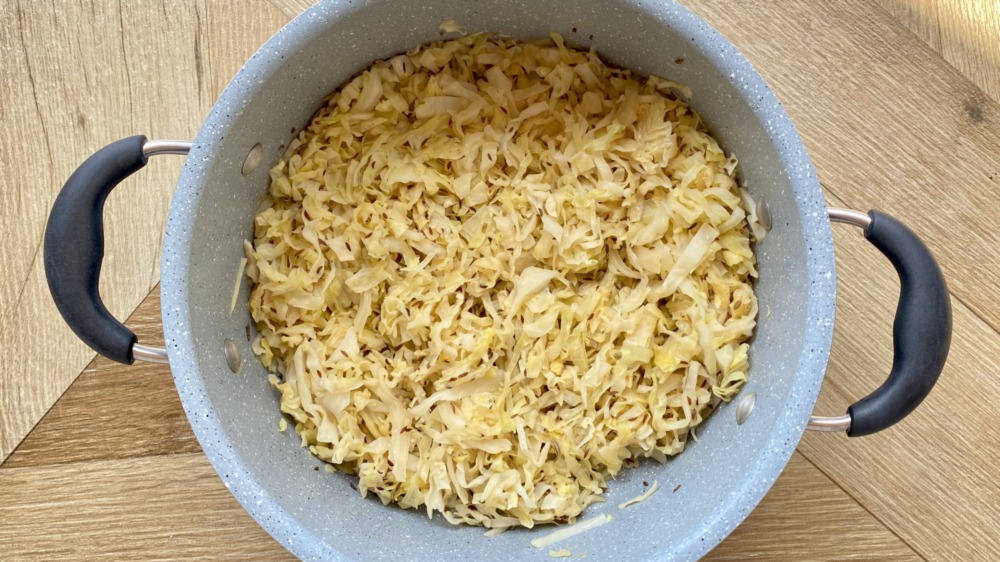Homemade Sauerkraut Recipe
If you think of homemade sauerkraut as a topping for hot dogs or German sausages and that's pretty much it, then you need to do a bit of re-thinking. There are few better (and cheaper!) ways to add a serious flavor injection to all sorts of dishes than by spooning on some of this salty, savory, tangy stuff, a foodstuff you can make yourself at home in a matter of minutes and then keep on hand for weeks.
Part of the reason people overlook sauerkraut is a misconception of it as a mere condiment as opposed to a versatile ingredient. Chef and recipe developer Maren Epstein of Eating Works says, "I like putting sauerkraut on unexpected dishes to add umami flavor like in miso soup or on salads. Of course, you can always put it on top of a hot dog like a regular person."
Epstein also touts the nutritional value, adding, "Sauerkraut is one of the most underrated super foods on the planet, and you should utilize any excuse to eat it for its gut-healing abilities." This is seconded by Healthline, which states in an article: "Unpasteurized sauerkraut contains probiotics, which are beneficial bacteria that act as the first line of defense against toxins and harmful bacteria. They can also improve your digestion and overall health."
Healthy and delicious? And easy to make? It checks all the right boxes.
Did you know sauerkraut isn't originally German?
Today, sauerkraut is most commonly associated with German cuisine, and that's all well and good, because it's all but impossible to beat a German sausage topped with sauerkraut and washed down with a cold Sion Kolsch. Indeed "sauerkraut" is a German word with "sauer" meaning sour and "kraut" meaning herb.
But historically, according to The New York Times, sauerkraut started in China. It turns out, lots of cultures around the world like fermenting hearty vegetables that give foods a pleasantly savory crunch.
Gather your ingredients for homemade sauerkraut
It doesn't take much to make a great batch of sauerkraut. In fact, aside from the cabbage itself, you likely have all you need in your kitchen already.
For this take on homemade sauerkraut, you'll need a head of green cabbage, kosher salt, white champagne vinegar, caraway seeds, and fennel seeds. And possibly some salted water, too. The preparation and cooking call for a spoon or spatula for stirring, a knife, a bowl, a pot, and a jar, and really that's it. Which is all pretty manageable, no?
Slice the cabbage and mix the spices for this homemade sauerkraut
To make great homemade sauerkraut, you have got to get the cutting right. Only perfectly sliced cabbage yields sauerkraut with the right taste and feel, so take your time on the prep.
First, quarter the cabbage and remove the core from each piece. Now, chiffonade the cabbage into thin slices each between one and two inches in length. ("Chiffonade" means to finely slice leafy vegetables, FYI.) Place the thinly sliced cabbage in a bowl, and combine it with the salt.
Next, in a small bowl, mix the vinegar, caraway, and fennel seeds. Transfer half of this mixture to a medium pot, and then add the cabbage. Now pour the rest of the vinegar and herb mixture on top of the sliced cabbage, then combine everything with a spatula and cover the pot with a lid.
Cook your cabbage into homemade sauerkraut
Cook the cabbage, herb, and vinegar mixture on medium-low heat for 40 minutes, stirring occasionally. If the pot looks dry during the course of the cooking, add a quarter cup of salted water and stir. The cabbage is done once it is wilted and all of the pieces look "wet."
Remove the pot from the flame and transfer the sauerkraut to a clean lidded jar. Place it in the fridge for up to two weeks, and note that the sauerkraut will slowly ferment and become more sour over time. If the sauerkraut is growing dry, you can fill the jar with salt water until all of the cabbage is covered. This will preserve it even further.
Meanwhile, enjoy the homemade sauerkraut in soups, sandwiches, salads, or of course on brats and hotdogs.

- 1 cabbage, chiffonaded
- 1 teaspoon kosher salt
- ½ cup white champagne vinegar
- 1 tablespoon caraway seeds
- 1 teaspoon fennel seeds
- Quarter the cabbage and remove the core, then chiffonade the cabbage into thin slices 1 to 2 inches in length.
- Place sliced cabbage in a bowl and combine with the salt.
- In a small bowl, mix the vinegar, caraway, and fennel seeds, then transfer half of the mixture to a medium pot.
- Add the cabbage and pour the rest of the vinegar and herb mixture over the top, then combine with a spatula and cover with a lid.
- Cook on medium-low heat for 40 minutes, stirring occasionally. If the pot looks dry, add a quarter cup of salted water.
- The cabbage is done once it is wilted and all of the pieces look wet. Remove from the flame and transfer to a lidded jar.
- Keep in the fridge for up to two weeks. The homemade sauerkraut will slowly ferment and become more sour over time.
| Calories per Serving | 27 |
| Total Fat | 0.6 g |
| Saturated Fat | 0.0 g |
| Trans Fat | 0.0 g |
| Cholesterol | 0.0 mg |
| Total Carbohydrates | 2.7 g |
| Dietary Fiber | 1.9 g |
| Total Sugars | 0.3 g |
| Sodium | 165.9 mg |
| Protein | 0.9 g |





